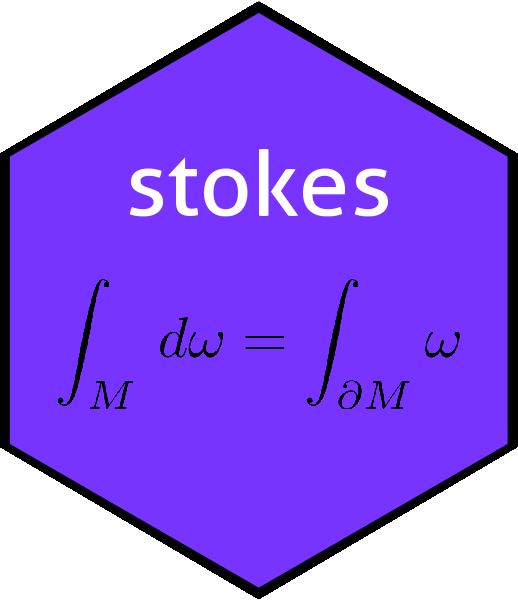

The stokes package provides functionality for working
with the exterior calculus. It includes tensor products and wedge
products and a variety of use-cases. The canonical reference would be
Spivak (see references). A detailed vignette is provided in the
package.
The package deals with -tensors and -forms. A -tensor is a multilinear map , where is considered as a vector space. Given two -tensors the package can calculate their outer product using natural R idiom (see below and the vignette for details).
A -form is an alternating -tensor, that is a -tensor with the property that linear dependence of implies that . Given -forms , the package provides R idiom for calculating their wedge product .
You can install the released version of stokes from CRAN with:
# install.packages("stokes") # uncomment this to install the package
library("stokes")
set.seed(0)stokes package in
useThe package has two main classes of objects, kform and
ktensor. In the package, we can create a -tensor by
supplying function as.ktensor() a matrix of indices and a
vector of coefficients, for example:
jj <- as.ktensor(rbind(1:3,2:4),1:2)
jj
#> A linear map from V^3 to R with V=R^4:
#> val
#> 2 3 4 = 2
#> 1 2 3 = 1Above, object jj is equal to
(see Spivak, p76 for details).
We can coerce tensors to a function and then evaluate it:
KT <- as.ktensor(cbind(1:4,2:5),1:4)
f <- as.function(KT)
E <- matrix(rnorm(10),5,2)
f(E)
#> [1] 11.23556Tensor products are implemented:
KT %X% KT
#> A linear map from V^4 to R with V=R^5:
#> val
#> 1 2 1 2 = 1
#> 2 3 1 2 = 2
#> 3 4 3 4 = 9
#> 2 3 4 5 = 8
#> 1 2 2 3 = 2
#> 1 2 4 5 = 4
#> 4 5 4 5 = 16
#> 2 3 3 4 = 6
#> 4 5 3 4 = 12
#> 1 2 3 4 = 3
#> 3 4 4 5 = 12
#> 3 4 2 3 = 6
#> 4 5 2 3 = 8
#> 3 4 1 2 = 3
#> 2 3 2 3 = 4
#> 4 5 1 2 = 4Above we see .
An alternating form (or -form) is an
antisymmetric -tensor; the package can convert a general -tensor to
alternating form using the Alt() function:
Alt(KT)
#> A linear map from V^2 to R with V=R^5:
#> val
#> 5 4 = -2.0
#> 4 5 = 2.0
#> 4 3 = -1.5
#> 3 2 = -1.0
#> 2 3 = 1.0
#> 3 4 = 1.5
#> 2 1 = -0.5
#> 1 2 = 0.5However, the package provides a bespoke and efficient representation
for -forms as objects with class kform. Such
objects may be created using the as.kform() function:
M <- matrix(c(4,2,3,1,2,4),2,3,byrow=TRUE)
M
#> [,1] [,2] [,3]
#> [1,] 4 2 3
#> [2,] 1 2 4
KF <- as.kform(M,c(1,5))
KF
#> An alternating linear map from V^3 to R with V=R^4:
#> val
#> 1 2 4 = 5
#> 2 3 4 = 1Above, we see that KF is equal to . We
may coerce KF to functional form:
f <- as.function(KF)
E <- matrix(rnorm(12),4,3)
f(E)
#> [1] -5.979544Above, we evaluate KF at a point in [the three columns of matrix
E are each interpreted as vectors in ].
The wedge product of two -forms is
implemented as ^ or wedge():
KF2 <- kform_general(6:9,2,1:6)
KF2
#> An alternating linear map from V^2 to R with V=R^9:
#> val
#> 8 9 = 6
#> 7 9 = 5
#> 6 9 = 4
#> 7 8 = 3
#> 6 8 = 2
#> 6 7 = 1
KF ^ KF2
#> An alternating linear map from V^5 to R with V=R^9:
#> val
#> 1 2 4 6 7 = 5
#> 1 2 4 6 8 = 10
#> 2 3 4 6 8 = 2
#> 2 3 4 7 8 = 3
#> 2 3 4 6 9 = 4
#> 1 2 4 6 9 = 20
#> 2 3 4 6 7 = 1
#> 2 3 4 7 9 = 5
#> 1 2 4 7 8 = 15
#> 2 3 4 8 9 = 6
#> 1 2 4 7 9 = 25
#> 1 2 4 8 9 = 30The package can accommodate a number of results from the exterior calculus such as elementary forms:
dx <- as.kform(1)
dy <- as.kform(2)
dz <- as.kform(3)
dx ^ dy ^ dz # element of volume
#> An alternating linear map from V^3 to R with V=R^3:
#> val
#> 1 2 3 = 1A number of useful functions from the exterior calculus are provided, such as the gradient of a scalar function:
grad(1:6)
#> An alternating linear map from V^1 to R with V=R^6:
#> val
#> 6 = 6
#> 5 = 5
#> 4 = 4
#> 3 = 3
#> 2 = 2
#> 1 = 1The package takes the leg-work out of the exterior calculus:
grad(1:4) ^ grad(1:6)
#> An alternating linear map from V^2 to R with V=R^6:
#> val
#> 4 5 = 20
#> 1 5 = 5
#> 2 5 = 10
#> 3 5 = 15
#> 2 6 = 12
#> 4 6 = 24
#> 3 6 = 18
#> 1 6 = 6The most concise reference is
But a more leisurely book would be
For more detail, see the package vignette
vignette("stokes")